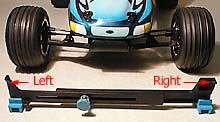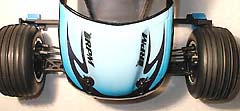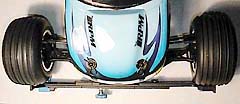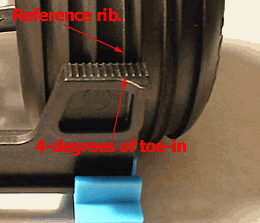This is a very common question here at RPM. The procedure to use our Toe-In Gauge is covered in the instructions included with the gauge. However, we’ll explain how to use it here along with a few descriptive photos not available in the instructions.
Important: All toe-in measurements should be taken with the vehicle at static ride height. The gauge should only be used on smooth, flat surfaces. Place the gauge on its bottom edge where there are two small feet used to stabilize the gauge in that position. The blue knob should be facing toward you. You should be looking straight down at the top edge of the gauge. The left end of the gauge looks like a whale’s tail (these are the pointers). The right end has a graduated scale and a single pointer. Each line on the scale represents 1° of the total toe-in (1/2° per side).

Please note that all references to “left” and “right” are your left and right while looking at the vehicle from the front — NOT the vehicle’s left and right! Keep only light tension on the spring-loaded, blue knob. Place the gauge to the rear side of the front tires. Slide the gauge partially open. If you are checking an off-road truck, install the risers just to the outside of the balancing feet. The risers should sit under the toe-in gauge as shown in the photo above. The front of the vehicle should still be facing you. Place the gauge under the vehicle, behind the front tires (as shown in the picture below).
The blue knob must be facing toward you. Choose a rib on each tire. These ribs will be the reference ribs. Carefully place one gauge pointer against the inside of the reference rib. Now slide the gauge open until the gauge pointer on the other end touches the inside of the reference rib on the other tire. Gently remove your gauge from under the vehicle, then reset your ride height. Place the gauge in front of the tires with the blue knob still facing you (as shown below). Now, only the left gauge pointer will be facing the tire.
Place this pointer against the inside edge of the same reference rib. On the right side, the reference rib will be lined up with one of the lines on the graduated scale. The outside end of the scale represents 0°. Each line inwards represents 1° of toe-in. Read the gauge at the point where the reference rib lines up with the line on the scale. The “toe angle” of the toe-in gauge is read by counting the lines in from the outside.
Referencing the photo below, the edge of the reference rib is even with the fourth line of the gauge, therefore the amount of toe-in is 4°. (If the reference rib does not line up with any lines on the scale, then you have toe-out. Adjust your turnbuckles until you get the proper amount of Toe-In or see “Checking Toe-Out” below.) If the gauge is left locked down, the vehicle can be rapidly checked for toe-in changes after a crash simply by placing the gauge in front of the tires and, using the same reference ribs, checking to see if the toe has changed.
Sedans and Other Vehicles with a Narrow Chassis
If you cannot get the toe-gauge to collapse far enough for a narrow chassis, there is a second hole in your toe-gauge for the blue knob that allows the ends, or pointers, to come closer together. Simply remove the knob from the standard position, close the gauge until the slot reveals the second threaded hole, then reinstall the knob. Due to tighter tire tread designs or the use of slick racing tires, it may be necessary to use the inside edge of the tires for your reference edges. Use the small risers or some thin, equal thickness spacers (one under each front tire) to elevate the chassis to enable you to stand the gauge up behind the tires.
Checking Toe-Out (Very rarely used!)
If you prefer to run toe-out or the condition described above is prevalent, then toe-out may be checked simply by starting from the front of the tires and finishing by taking the reading from the back of the tires. The only exception being the blue knob must now face the rear of the vehicle throughout the procedure.



